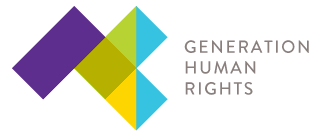Overview
In this lesson students will have a chance to explore quotes from three interviews that Generation Human Rights interns led with Indigenous water activists. Brophy Toledo is a member of the Jimez and Santa Domingo tribes. Megan Begay was raised by her mother in the city, but is now taking time to connect to her father and her Navajo roots. Lisa Bellenger is a member of the Ojibwe and Dakota tribes and is the Anishinaabe water carrier. Students will break into groups of four and discuss quotes by one of the Indigenous water activists with support by discussion question prompts. They will then create a five-minute presentation to share at in the last activity of the class.
Grade Level
8th-12th Grades
Essential questions the lesson will address:
● Can the Indigenous people’s teachings about water encourage youth outside of Indigenous communities to protect our most valuable resource?
Learning Outcomes
Students will be able to:
● Design and deliver a presentation to their class.
● Synthesize their knowledge of the previous classes to analyze the quotes from the Indigenous water activists.
● Think ‘out of the box’ and develop creative elements for their group presentation.
Common Core State Standards (9th Grade)
Water Warriors Glossary and Concepts
● Indigenous peoples: Considering the diversity of Indigenous peoples, an official definition of “indigenous” has not been adopted by any UN-system body. Instead, the system has developed a modern understanding of this term based on the following:
○ Self-identification as Indigenous peoples at the individual level and accepted by the community as their member
○ Historical continuity with pre-colonial and/or pre-settler societies
○ Strong link to territories and surrounding natural resources
○ Distinct social, economic or political systems
○ Distinct language, culture and beliefs
○ Form non-dominant groups of society
○ Resolve to maintain and reproduce their ancestral environments and systems as distinctive peoples and communities. (CITE The Fact Sheet)
● Tribal Sovereignty: Tribal sovereignty refers to the right of American Indians and Alaska Natives to govern themselves. Sovereignty for tribes includes the right to establish their own form of government, determine membership requirements, enact legislation, and establish law enforcement and court systems.(National Conference of State Legislatures (NCSL)
● UN Declaration on the Rights of Indigenous Peoples (UNDRIP): A universal framework of minimum standards for the survival, dignity, and well-being of the Indigenous peoples of the world. It elaborates on existing human rights standards and fundamental freedoms as they apply to the specific situation of Indigenous peoples, The UN General Assembly adopted the UNDRIP in 2007. (United Nations Declaration on the Rights of Indigenous Peoples)
International Document Reference
● Universal Declaration of Human Rights (UDHR): Article 2, Article 18, and Article 27
● UN Declaration on the Rights of Indigenous Peoples (UNDRIP): Article 1, Article 2, Article 11, and Article 12
Formative Assessment Strategies (What will you be looking for in their work, and how?)
The teacher can make note of:
● Individual student engagement while working within groups.
● Group participation in the class presentation.
● Collaboration among students as they create their presentations.
Materials for Instructor
● Whiteboard, Blackboard, SmartBoard, or Flip Chart
● Water Warriors Glossary Board (Physical or Virtual)
Materials for Students
● Water Warriors Journal
● Indigenous Voices Quotes and Prompt Questions worksheet (There are three different pages, each group should receive only one page.)
LESSON PLAN
I. Discussion and Introduction (5 min.)
Share with students that now they have now learned about the Universal Declaration of Human Rights (UDHR) and the United Nations Declaration on Indigenous Peoples (UNDRIP), it is time to learn about Indigenous water activists. Before beginning the first activity, ask students what they remember about the two documents and what they feel is most important about each of them. Have students share their answers aloud popcorn-style.
Remind students of the following:
● The UDHR contains 32 articles that allot human rights to every individual on earth.
● The UNDRIP was created to support Indigenous peoples to be allocated full respect and dignity. It also supports Indigenous peoples to maintain their own sovereign nations.
II. Presentation Preparation (25 min.)
Step One. (5 min.)
Break students into groups of four people. Have each group choose one member to be the “scribe.” The scribe will take notes during the group discussion, but will also be a part of the discussion when possible.
Step Two. (10 min.)
Hand each group a worksheet representing one Indigenous water activist. Have students read through the quotes together out loud. After they have read the quotes, have them answer and discuss the questions.
Step Three. (10 min.)
It is time to create the presentation:
● Tell students to write a one paragraph bio about the Indigenous water activist based on the quotes as a group.
Explain to students that they will begin their presentation by sharing the bio they have written as a group. However, this will only be 1-2 minutes of their presentation. They will have 3 more minutes to fill. Encourage them to be creative. Possibly one or more of the questions inspired them to think “out of the box.” Let students know they can go beyond the questions and they can brainstorm and use their imagination.
III. Presentations (20 min.)
Ask if there is one group that would like to volunteer to go first. If not, randomly assign the order of presentations.

